#ictalurids
Text

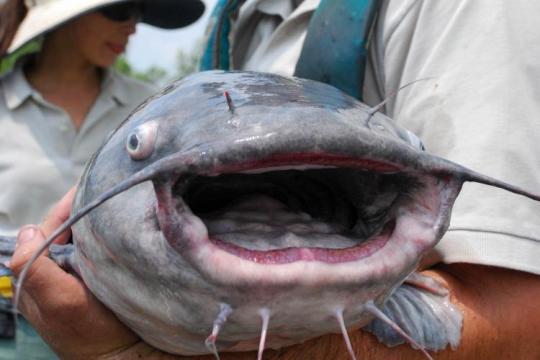
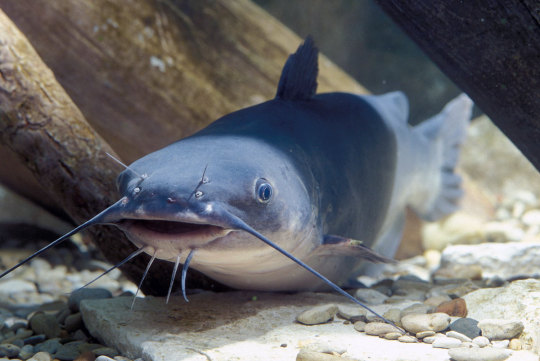
The Beautiful Blue Catfish
Blue catfish (Ictalurus furcatus) are members of the bullhead catfish family, native to the drainages of the Mississippi, Missouri, and Ohio river basins and the Gulf of Mexico. Because of their popularity as game fish, this species has also been introduced to freshwater systems throughout North and South America, and is considered invasive in these areas.
Like many catfish, I. furcatus is a bottom dweller. They can often be found near complex structures such as rocky outcroppings, fallen trees, or sunken structures that provide both food and shelter. The blue catfish is an opportunistic predator, consuming any fish or aquatic invertebrates it can find, as well as eggs, small amphibians, and injured or recently deceased animals. Adult I. furcatus are seldom prey for other species due to their size, but hatchlings and juveniles are often food for cormorants, willets, osprey, pelicans, and bald eagles. To deter predators, this species has serrated barbs along their dorsal and pectoral fins, each laced with a particularly painful toxin.
Though they can be difficult prey for other animals, the blue catfish is a popular target for fishermen, and for good reason; they're the largest species of catfish in North America. Adults can easily reach a length of 65 in (170 cm) and a weight of 165 lb (75 kg). As indicated by their name, most individuals are grey or blue, with a lighter underbelly. This species also lacks scales, a common characteristic of catfish, and the face is framed by long whisker-like barbels that help it detect nearby food.
While generally solitary, blue catfish aren't territorial, and tend to ignore each other until the mating season. Reproduction begins in April and continues until June, during which time males attract a female by building a nest and releasing attractive pheromones. Once a female has selected a male, she lays between 4,000-8,000 eggs per kilogram of bodyweight in his nest (i.e. if the female weighs 2 kg, she may lay between 8,000-16,000 eggs). The male then disperses sperm over the eggs. Following fertilization, the male chases away the female and guards the nest for about a week, at which time the eggs hatch. The hatchlings, also known as fry, stay close together in schools for several weeks before growing large enough to disperse. It will take them a further 5 years for them to reach maturity; on average individuals live about 10 years, but can live as long as 25.
Conservation status: The blue catfish is considered Least Concern by the IUCN. Within its native range, populations face minor threats from dams and droughts. Where it has been introduced, the species is considered invasive due to its voracious appetite.
If you like what I do, consider leaving a tip or buying me a ko-fi!
Photos
Missouri Department of Conservation
NOAA
Earl Nottingham
#blue catfish#Siluriformes#Ictaluridae#ictalurids#catfish#ray finned fish#bony fish#fish#freshwater fauna#freshwater fish#rivers#river fish#lakes#lake fish#north america#southern north america
218 notes
·
View notes
Note
is ictalurid something related to fish? it's such an aesthetically pleasing word.
yes!! isnt it? it refers to a member of the family ictaluridae, a group of catfish native to north america. it includes most you'd know if you live here (pretty much just excludes the saltwater ones). i like catfish

5 notes
·
View notes
Note
I’ve had no luck personally, but I can’t find any place that sells Fallfish, though I see creek chubs all the time. Is there any chance I might find one for sale? By the way, sorry for flooding you guys with my insane questions.
Sorry, none that I know of! There's not much of a market for the majority of native fishes, and those that are for sale are very specific (usually sunfish, certain genera of daces/shiners, ictalurid catfish, killifish, and livebearers - also our small assortment of native cichlids and tetras).
For a species like Fallfish, which have no market presence at all, your choices are limited to:
a) Catch your own. Not really hard to do, given you live in the right range, know where to find them, and are legally allowed to collect them.
b) Check around with local fish keeping clubs or native fish enthusiasts. Not very likely to have them - but you never know.
c) Check with local bait stores. I have heard of them being sold in buckets of assorted minnows in Maine (and saw an infographic stating this as a possibility in Michigan). Maybe your local bait store will let you fish around with a net and see what they have in stock. Odds are they have no idea what they actually purchased.
And no worries! I hope what I'm providing is somewhat helpful.
3 notes
·
View notes
Text
Tadpole madtom
I wish I had maintained the tadpole madtom, Noturus gyrinus. The genus Noturus, or madtoms, are venomous but non-lethal catfish, the species of which are all very similar in their loach-like appearance. Many of the notes made here, might well apply also, to other madtoms in captivity. Although, the diffetent species of Noturus do vary in nature as to their preferences, regarding parameters such as water clarity and flow.
This catfish inhabits acidic waters, and has been collected, even, from stagnant environments with a pH of 4.5. In the aquarium, the pH can be as high as 7,with no ill effects reported. They like a muddy or sandy substrate, with the option of soft sand, being more suitable for the aquarium. N. gyrinus also likes vegetated waters,either still or slow flowing, so the aquarium should be planted appropriately. These are fish from the USA and Canada, so the temperture should not exceed 22 degrees centigrade, for extended periods of time.
This small catfish is an ictalurid, or North American endemic catfish, growing to around 13 centimeters, or 5 inches long. Individuals over 4.5 centimeter take large prey such as glass shrimp and worms, so small fish may theoretically end up prey, but certainly adult shiners and darters have been maintained as cohabitants of N. gyrinus, without incident. It can be considered a community apt species, if its temperture needs are respected. But I doubt many aquarists outside North America, have had the pleasure of keeping madtoms.
0 notes
Note
ictalurid, op of the cme out! magazine w illustrations of two naked couples, is a radfem
Hi sorry only just seen this and thank you for letting me know! Will delete the reblog, it's a shame cause they're great illustrations but alas no radfems on my blog!! 💕
0 notes
Note
I hate to do this again but ictalurid (an account you reblogged some art from) is also a terf (the art in question is the naked lesbian and naked gay couple just cuddling) If you want some help avoiding that sort in the future, I have the shinigami eyes extension and it pretty reliably marks transphobes.
gross!
does the shinigami extension work on mobile?
13 notes
·
View notes
Text
Terf List Part 2
For all your content filtering needs. Make your dash a little cleaner.
ragewoman69
kronkk
vestalinnenfeuer
never-gender
itsjustwokehomophobia
homosaccharide
terfery
transrapeculturemisogynyreceipts
ipbans
terf-alice
breadiestofbread
lilithslabrys
irate-badfem-harpy
disillusionedmonster
letters-from-x
kittiesatemypronouns
layingdownsomebatfeets
radical-coffeeclub
lamec0rpse
terfiewerfie
radgoldgreen
centipedehurts
its-terftime
radfemrin
bellmeare
austereanastasia
universe246
venus-fire
nessajana
ictalurid
tradbimbo
thefolxawakens
etesienne
fallenumbreon
radgyne
blanketmadeof
bodenor
the-toilet-water
sansaralias
radicaltornado
dworkinsdaughter
vulvataster
cantthinkofausername-tbc
chaoticlesbianenergy4
lesbianlesbianlesbianlesb
salty-lesbians
medusareborn
porkoid
rabiddyke
shefoid
Thank you to everyone who submitted names!
Remember, don’t harass people! It’s a shitty thing to do no matter what.
If anyone has updates on the blogs mentioned above, let me know. Some might be old or out of date, and some may have grown.
[1] [2]
#transphobia#transphobes#block list#filter list#report list#you may notice the mentions are gone#it was funny the first time but I figure it would just be rude the second#ask to tag
24 notes
·
View notes
Note
hi Laci, I just wanted to let you know that a post you reblogged had an OP that was flagged by shinigami eyes (a browser extension I have that flags transphobic sources and identifies trans-friendly sources). ictalurid is the OP, and that's the blog flagged by the extension as transphobic. the post is art from come out magazine, harmless content, but I try to let anyone know when I notice a blog they've somehow interacted with is flagged as transphobic since I figure most ppl aren't aware :)
Thank you love bug! It's been deleted. ☺️
2 notes
·
View notes
Note
Why subscribe to radical feminism when it leaves out so many women? It's not true feminism if you're choosing to spread hate about transwomen. Really think about what you're doing here and if it's a true reflection of yourself.
i dont know what kind of misinformation you've read about radical feminism but lets start with the basics!! :
- there's a difference between oppression and discrimination, women face oppression based on our sex, trans face discrimination
- the only way of being a woman is biologically
- "transwomen" are actually men with body dysphoria
- radical feminism DOES include all women: fat, skinny, woc, white, tall, short, disabled...
and as i mention before, im a lesbian woc who lives in méxico. a country where 10 women are being killed every single fucking day. the reality of women is not gonna change because yall want us to make you feel comfortable, im not "subscribed" to radfem, this is my political reality and i stan with it
also, if trans women are women, then what makes us women?

© for the chart to: ictalurid
31 notes
·
View notes
Text
Listen I have five thought-out emotions towards animal groups and they are:
spitting rage towards Dipterans
delighted admiration for toadbugs (this blog's namesake), Chiroptera, and Hyaenids
wary appreciation of Ictalurids/Odonata/Veliids
physics-based intrigue for Dinosaurs and reptiles (including birds)
and Please God Don't Ever Put Me In a Field Alone With A Boar
#this is disregarding the no thoughts head empty blind love for favorite/cute animals ok. i said thought-out emotions.#biology#zoology#science#animals#wildlife#grizzly speaks
2 notes
·
View notes
Text

Which of these is best ictalurids is catfish (their family is ictaluridae and ictalurids refers to members of the family ictaluridae)
1 note
·
View note
Text
Uncharismatic Fact of the Day
What do you call a fish with no eyes? A Mexican blindcat! These fish, known as bagre de muzquiz in Mexico, dwell in caves up to 610 m (2,000 ft) underground, and because there is no light this species no longer have any eyes. Instead they have a highly developed sense of smell, and special nerves called lateral lines that run along the length of their bodies helps them detect motion in the water around them.
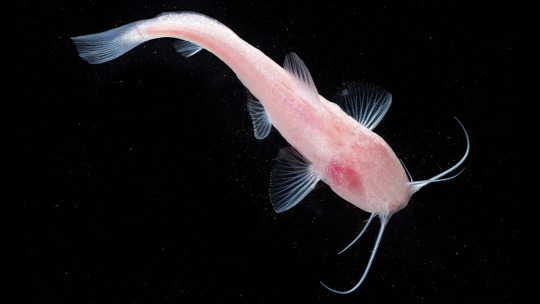
(Image: A mexican blindcat (Prietella phreatophila) by Jean Krejca)
If you like what I do, consider leaving a tip or buying me a ko-fi!
#mexican blindcat#Siluriformes#Ictaluridae#Ictalurids#catfish#ray-finned fish#bony fish#fish#uncharismatic facts
288 notes
·
View notes
Text
Asia Pacific Aquaculture Vaccines Market Revenue Growth Predicted at 8.2% through 2027
According to a recent study from market research firm Graphical Research, the Asia Pacific aquaculture vaccines market size is poised to expand at substantial CAGR during the forecast period. While the aquaculture industry in Asia Pacific is growing steadily, the widespread occurrence of numerous viral and bacterial infections is a major challenge for aquaculture companies. This in turn is creating a positive growth outlook for the Asia Pacific aquaculture vaccines market.
Vaccines are among the most efficient for of treatment for a wide variety of diseases. Vaccination of fish and other aquaculture species is crucial to ensuring social, economic, and environmental sustainability in the fish farming sector. Most licensed vaccines contain inactivated microbes formulated with adjuvants and administered through immersion and injection routes.
Get sample copy of this research report @ https://www.graphicalresearch.com/request/1675/sample
Fish immunization has been around for several decades and will continue to play a prominent role in the prevention of bacterial and viral infections. In terms of annual revenue, the Asia Pacific aquaculture vaccines industry size is projected to reach USD 37.4 million by the year 2027.
Vaccines used in aquaculture can be generally classified into live vaccines and inactivated vaccines, among others. Live vaccines are formulated from one or more viruses or bacteria displaying natural or attenuated virulence towards the target species. These vaccines tend to be more immunogenic compared to others due to their ability to enter the host and stimulate cellular responses linked to both innate and adaptive immunity.
The live aquaculture vaccines industry in Asia Pacific was valued at USD 3.5 million in 2020 and it will record commendable growth in the forthcoming years. Inactivated vaccines or killed vaccines on the other hand are less expensive and are highly affected against a range of diseases. They are generally found to be safe as they don’t persist within the environment and induce short lived immunity among the target species.
The Asia Pacific market for inactivated aquaculture vaccines generated USD 17.6 million in 2020 and will grow substantially by 2027.
Immersion and injections are among the commonly used routes of administration for vaccines in aquaculture species. Immersion vaccines are generally preferred during mass vaccination of fish. Numerous methods have been introduced to enhance the safety and efficacy of immersion vaccination. The demand for immersion vaccines is set to increase at a notable CAGR of 8.7% in the forthcoming years.
Injection vaccines typically include water or oil based compounds called adjuvants that stimulate the immune response. Injection vaccination is effective against a variety of pathogens that cause systemic disease, offering protection for six months to one year. The adoption of injection vaccines is likely to grow at a CAGR of 7.9% up to 2027.
The different types of viruses that affect aquaculture species include infectious haemorrhagic septicaemia viruses, infectious haematopoietic necrosis viruses, and salmon anemia. These viruses cause heavy economic loss for fish farmers and the acculture sector. Asia Pacific aquaculture vaccines industry share from viral infections will expand at an 8.5% CAGR in the future.
Meanwhile, the bacterial infection applications will account for a revenue share of around USD 24.7 million by the year 2027. Numerous types of bacteria such as Streptococcus spp, E tardawo, and Edwardsiella ictalurid are among the leading causes of bacterial infections and diseases such as acute hepatopancreatic necrosis and hepatopancreatic microsporidiosis.
China aquaculture vaccines market size is slated to reach USD 12.2 million by 2027, growing at a CAGR of nearly 8.1%. The country has witnessed increased production of tilapia and other fish species. According to the 2017 NOAA Fisheries report, China produces more than 49,244,101 metric tons of fish, crustaceans, and mullusks. Widespread occurrence of various diseases outbreaks will complement the regional outlook.
Request for customization @ https://www.graphicalresearch.com/request/1675/customize-this-report
Meanwhile, the aquaculture vaccines industry in Australia will grow at a CAGR of 8.5% in the next few years. Australia’s aquaculture production increased by 4% in 2018 to reach 97.672 tons, as per the 2018 Australian Fisheries and Aquaculture report. These numbers are likely to further increase over the coming years, providing the local manufacturers with lucrative opportunities.
Table of Contents (ToC) of the report:
Chapter 1 Methodology
1.1 Definition and forecast parameters
1.1.1 Definitions
1.1.2 Methodology and forecast parameters
1.2 Data sources
1.3 References & sources
1.3.1 Secondary
1.3.2 Primary
Chapter 2 Executive Summary
2.1 Asia Pacific aquaculture vaccines industry summary, 2016 – 2027
2.1.1 Country trends
2.1.2 Type of vaccines trends
2.1.3 Route of administration trends
2.1.4 Application trends
2.1.5 Species trends
Chapter 3 Industry Insights
3.1 Industry segmentation
3.2 Industry outlook, 2016 - 2027
3.3 Major factor analysis
3.3.1 Drivers
3.3.1.1 Surging prevalence of viral and bacterial infections
3.3.1.2 Increasing aquaculture production in the region
3.3.1.3 Development and launch of new aquaculture vaccines
3.3.1.4 Rising adoption of aquaculture vaccines against antibiotics
3.3.2 Industry pitfall and challenges
3.3.2.1 Stringent regulatory policies for vaccine approval
3.3.2.2 Complex vaccine development procedures
3.4 Growth potential analysis
3.4.1 By type of vaccines
3.4.2 By route of administration
3.4.3 By application
3.4.4 By species
3.5 COVID-19 impact analysis
3.6 Porter’s analysis
3.7 Competitive review, 2019
3.8 PEST analysis
Browse complete Table of Contents (ToC) of this research report @ https://www.graphicalresearch.com/table-of-content/1675/asia-pacific-aquaculture-vaccines-market
About Graphical Research:
Graphical Research is a business research firm that provides industry insights, market forecast and strategic inputs through granular research reports and advisory services. We publish targeted research reports with an aim to address varied customer needs, from market penetration and entry strategies to portfolio management and strategic outlook. We understand that business requirements are unique: our syndicate reports are designed to ensure relevance for industry participants across the value chain. We also provide custom reports that are tailored to the exact needs of the customer, with dedicated analyst support across the purchase lifecycle.
Contact Us:
Parikhit B.
Corporate Sales,
Graphical Research
Phone: 1-800-986-6917
Email: [email protected]
Web: https://www.graphicalresearch.com
#Asia Pacific Aquaculture Vaccines Market Analysis#Asia Pacific Aquaculture Vaccines Market by Type#Asia Pacific Aquaculture Vaccines Market Share#Asia Pacific Aquaculture Vaccines Market Development
0 notes
Photo

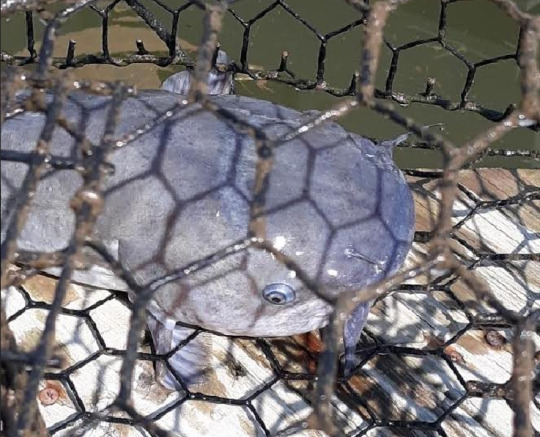
I got a text today during my work day from the parents - they pulled up a crab trap and, lo and behold, they caught a catfish! A big one, probably about 16 inches long. Also, no crabs. I’ll spoil it a bit, it’s a White Catfish (Ameiurus catus) but if you want to read the (somewhat frustrating story), click the below!
(I dunno why you would, unless you like hearing me talk. In which case, you are probably me reading this at a later date. Hi, me!)
So, first off, I love how people send me pictures of native fishes. It really is a joy. But I also love when it’s a bit of a puzzle. See, we have a number of Ictalurid catfish species in the local river, and this guy honestly could have been a White Catfish, a Blue Catfish, or less likely, a Channel Catfish (we also have Yellow Bullheads, Brown Bullheads, and Flatheads, but none of these matched the description). Of these, the Channels and Whites are native while the Blues are invasive. So I request a picture of this fella’s anal fin. (sorry if that’s too personal, my fishy friend!)
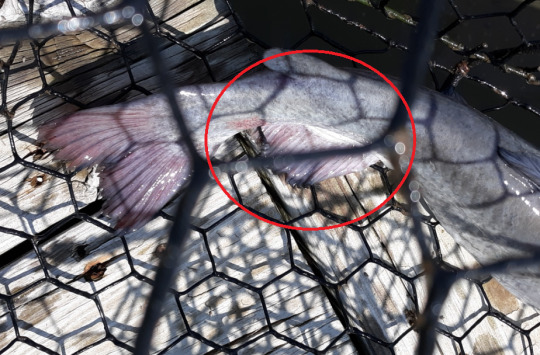
The rounded anal fin here sells it - this is a white catfish! Consulting the Peterson Field Guide to Freshwater Fishes of North America North of Mexico (’natch), you can see the difference between it and the related Blue Catfish.

So my mom talks to the people who own the pier, who tell her it’s an “Arkansas Blue Catfish”, is invasive, and needs to be killed. And though I provide her the information necessary to dispute that this is in fact a native species, they weren’t listening. And. Like. It’s incredibly frustrating to listen to people whose business is fishing boats (mostly recreational, some commercial) and they aren’t fully aware of the species of fish locally, especially when they are game fish. Below is a picture of a Blue Catfish I caught a year ago:
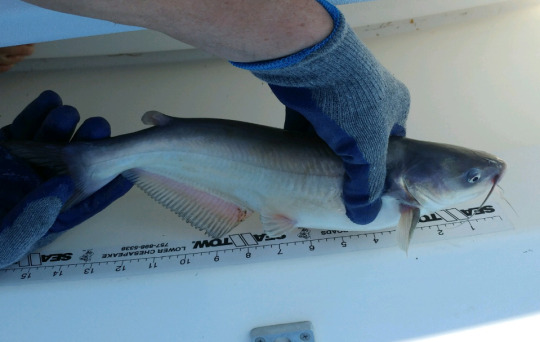
So in addition to the very different anal fin, the body shape is also much different. Bullheads have big ol’ heads. The fry honestly look like tadpoles because of it. This similar-sized Blue is more proportional to what you’d expect a fish to look like. The Blues also have a more deeply forked tail than the Whites, which isn’t super apparent here.
In any case. I went down there, got pictures to accurately document the species, and released him. I don’t think anything will come of it, but darn if that doesn’t grind on my nerves a little.
36 notes
·
View notes
Text
VA Native Fish Hunting - 12

This past weekend, the wife and I went camping with a friend of ours (and like 4 dogs between our groups). I was excited because the campground was near a marsh, which I am always a fan of, and I had heard rumors of people finding Snakeheads there. Unfortunately it was only an overnight trip so I only got to do a little fishing, but I found some neat stuff to share.


The marsh I went to was incredibly silty - each swipe of the net dug up lots of plants, roots and all with no resistance, and I felt bad about doing it too much. I really don't like to stress out the plants and animals too much, so I stopped after only a few. The two aquatic plants that were most plentiful were some sort of lilypad (I'm no good at ID'ing these - especially with no real prominent flowers) and hornwort. Common, but I am a fan.

Amphibious plants were also plentiful - mostly this type of sedge. I want to say Fox Sedge? But could be another type of sedge or spikerush for all I know. I still have lots to learn here.

The only fish I was able to catch were Eastern Mosquitofish, an extremely abundant fish locally. I caught maybe 12 or 15 specimens and no other fish species. Maybe a little disappointing, but I do like these guys.
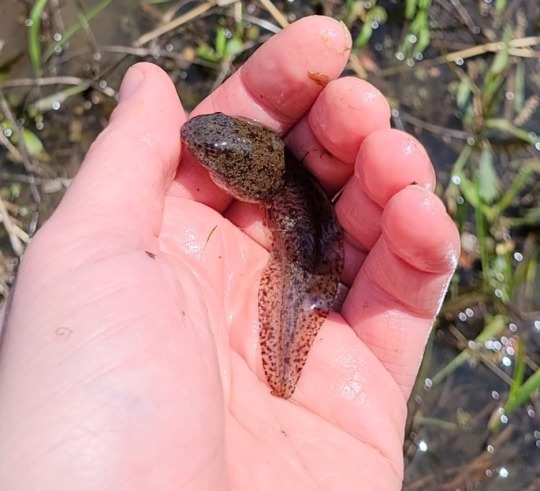
I also caught this really gorgeous tadpole! I think a Bullfrog, given the size, but I'm also not an expert here.

In the same swipe as the tadpole I also caught this crayfish! We have 34 species of naturalized and native species here in VA - I tend to think it is a Cambarus spp. (maybe a Common/Brook Crayfish) but if I had to bet money on it... well, I wouldn't.
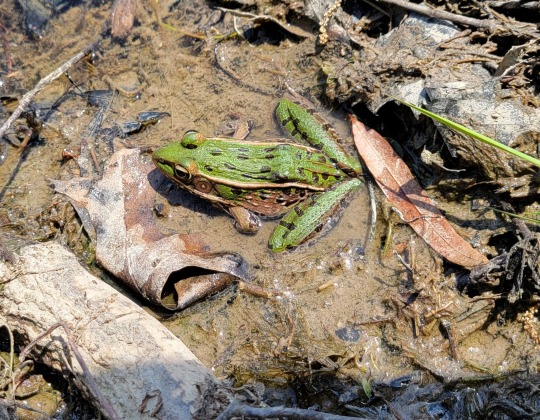
I didn't catch this guy, but he let me take some photos! Which was awfully nice of him because I'm a big scary human and he is a frog.

I also tried dipping here with no real luck - a few glass shrimps, but mostly dark black muck. My netting DID alert something very big in the water, maybe a foot or 16 inches, to come out and investigate, but with how silty the water was I couldn't get a good take on it. It did seem to come in and out of a hole in the cliff face, which leads me to believe an Ictalurid catfish of some sort.
21 notes
·
View notes
Text
VA Native Fish Hunting - 4

So last weekend we went Kayak camping on the James River here in VA. If you’ve ever taken a kayak or backpack to a campsite, then you know weight is the major limiting factor. Which meant I only got to take minimal equipment (2 dip nets) and had only a little luck. Still. Saw some neat stuff!
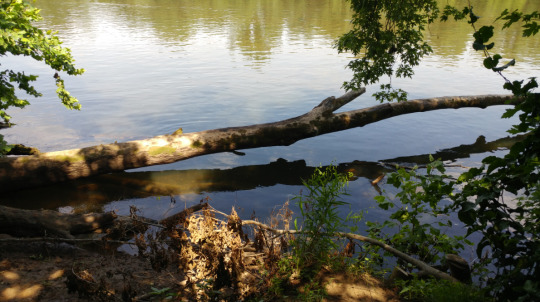
Okay I’ll be frank; a lot of what we did and saw involved us swimming in the river, so I didn’t bring my phone with me. I did find out later that my wife has a Go-pro with a water-proof case, so I’ll be bringing that with me next time.
This area right here was incredible though... within the span of an hour, we saw a foot long Ictalurid catfish (probably Channel but maybe a longer Bullhead), a 2 foot long Longnose Gar, several Green Sunfish of various lengths, and mixed schools of Satinfin Shiners and Blacknose Daces. I really was surprised to see them schooling together, but there was no mistaking them for one species.
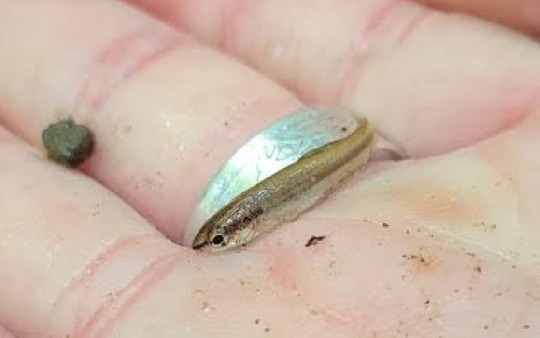
We also went up a small tributary where I went dipping with my net. Saw some smaller fish and confirmed they were Blacknose Daces. But I stopped after one dip just because it’s not worth stressing the little guys out for.

The dominant snail species were these long shelled dudes. I would need a good side-view to confirm, but pretty sure these are Pleurocera virginica, which is a species I have found in the nearby Rappahannock.
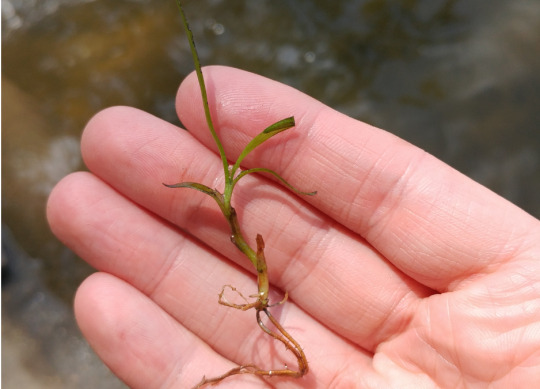
One thing I found fun about this river was that there was a few different aquatic plants in a small area. Most places I see are dominated by 1 or 2. The Northern Snail-Seed Pondweed (Potamogeton spirillus) - try saying that 10 times fast - was probably the most abundant. I have a bunch at home and love them as a temperate water plant.
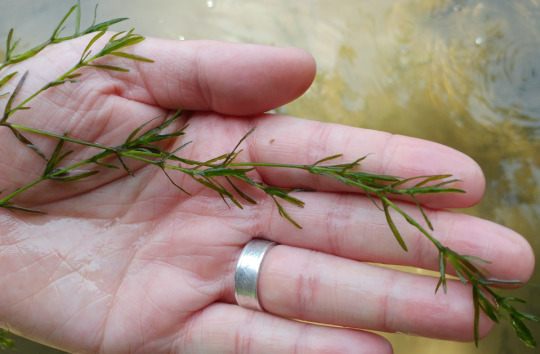
This one was new to me, though. Hill’s Pondweed (Potamogeton hillii) is a relative of the above plant and looks much the same in the water, just with shorter leaves. I picked some for a friend with a native tank, we’ll see how it does!
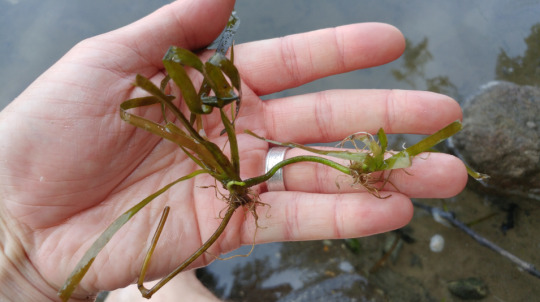
And of course, what would a trip to a major river be without stumbling upon some Vallisneria? There were super long strands in the water, maybe 2 or 3 feet long, but this guy washed up on shore, so... photo op!
14 notes
·
View notes